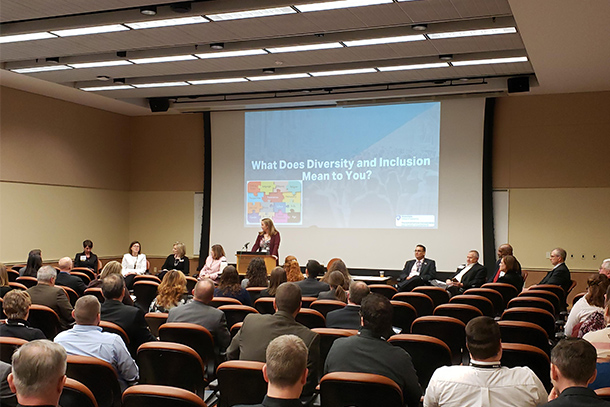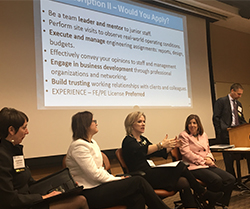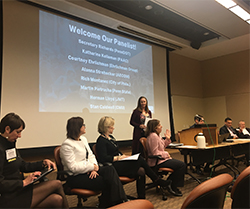
Featuring a diverse panel of industry leaders, agency representatives and engineering faculty, the TESC session, Diversity and Inclusion: Moving the Needle to Help Transform our Profession, offered a refreshing, yet appreciated discussion about gender, race, generational differences, communications and unconscious bias in the workplace.
Panelists address diversity and inclusion at Transportation Engineering and Safety Conference
12/21/2018
UNIVERSITY PARK, Pa.— Since its inception, the Transportation Engineering and Safety Conference (TESC), held recently at The Penn Stater Hotel and Conference Center, has remained true to its name with a program filled with traditional transportation engineering topics. Conference attendees have come to count on sessions about bridges, freeways, traffic signals and autonomous vehicles. But, for the first time in TESC history, the 2018 rendition took the road less traveled by introducing a topic that has been the focus of much attention, both within the transportation engineering industry and beyond: diversity and inclusion.
Featuring a diverse panel of industry leaders, agency representatives and engineering faculty, the TESC session, Diversity and Inclusion: Moving the Needle to Help Transform our Profession, offered a refreshing, yet appreciated discussion about gender, race, generational differences, communications and unconscious bias in the workplace. The men and women on the panel faced-off from opposite sides of the room to offer real-life experiences and suggestions. They addressed the wide-spread belief that millennials don’t want to use a phone for phone calls, the need for better job posting language, best practices for recruitment and work-life balance for employees in general—not just for mothers. Although the panel addressed various issues related to race and age, the topic of gender was of particular interest.
“A session like this was timely,” said Dan Corey, AECOM deputy national intelligent transportation systems (ITS) practice leader and 2018 TESC chair. “As the transportation industry has evolved over time, so has its diversity. With that, it is important for people to have an appreciation for what others believe, feel and do. By providing opportunities to learn about each other, we make ourselves stronger as leaders in the transportation industry.”
So, what can educators, industry leaders and fellow engineers do to increase diversity and inclusion within the transportation industry?
In an October 2018 interview about the College’s Engineering Equity Initiative, Justin Schwartz, Harold and Inge Marcus Dean of Engineering, Penn State called on universities and organizations to work together to increase diversity and inclusion. Reflecting the national average, the Penn State College of Engineering is currently 22 percent female, a number, Schwartz wants to see reach 50 percent by 2024.
“Starting at the University level, we have formal programs and support groups to encourage diversity and inclusion,” said Martin Pietrucha, undergraduate program coordinator and professor of civil engineering, Penn State. “We have a greater mix of students by gender and race than we had in 1990, but we still have more work to do.”
Yet, between enrollment, graduation and employment, the gender gap grows wider for women in transportation. According to the Federal Highway Administration, women make up only 8 percent of engineers in the transportation industry.
To recruit and maintain a well-balanced workforce, both men and women on the panel agreed that better communication, more exposure to differences and targeted diversity and inclusion training programs are key.
“During our hiring process, for example, all panels must include one female,” said Leslie S. Richards, secretary of transportation, Pennsylvania Department of Transportation (PennDOT) and one of the female panelists in the session. “We also reach out to schools and colleges more than we used to, and we ask females to talk to other females about their jobs to help encourage more women to apply.”
The Port Authority of Allegheny County follows similar practices during the hiring process, according to Katharine Kelleman, chief operating officer.
“We always include one female and one ethnic minority,” said Kelleman. “And, we also have initiated a ‘ban the box’ practice, where we don’t require applicants to disclose a criminal record. We also no longer ask salary history, which bakes in inequity by keeping candidates—especially those who may have taken time off to raise a family—at a lower salary level, based on history, not necessarily their expertise.”
Meanwhile, companies like JMT have created leadership roles and departments with diversity and inclusion in mind. In his newly-created position, Herman Lloyd, chief diversity and inclusion officer, JMT, and one of the male participants on the panel, is tasked with ensuring the firm employs a diverse workforce, fosters inclusive workplaces and provides opportunity for all employees. As an African American and 50-year veteran of the architectural engineering consulting industry, Lloyd knows a thing or two about diversity and inclusion in the workplace.
“Diversity is being invited to the party,” said Lloyd. “Inclusion is being asked to dance, but also what kind of music you like to dance to.”
The disparity between male and female representation, which is present both in academics and industry, has historically been reflected in TESC attendance figures. Over the past five years, female attendance at TESC has fluctuated between 14 and 17 percent. For 2018, although attendees and organizers alike commented on the visible increase in the number of female participants, still roughly only 17 percent of speakers or moderators were women.
But, the needle does appear to be moving ever so slightly in a positive direction for females, at least where TESC is concerned.
By percentage, the male versus female attendance comparison remained about the same for 2018. However, female attendance by actual numbers was the highest in TESC history, with more than 100 females in attendance. Additionally, a record-breaking number of more than 30 women either moderated sessions, participated as panelists or presented research.
If the needle can move for females at one of the most attended transportation engineering conferences in the region, maybe, just maybe, it can move for females in the rest of the industry, too.



